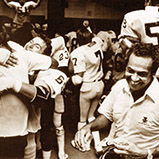Culture and Entrepreneurial Ventures
Professors John Perry and Masud Chand explore whether cultural factors influence individuals investment in new ventures.
 Cultural Influences in the Decision to Invest in New Ventures: An Exploratory Study
Cultural Influences in the Decision to Invest in New Ventures: An Exploratory Study
By Professors John Perry and Masud Chand
Do cultural factors influence whether individuals invest in new ventures? If so, do cultural factors influence in whose new ventures they invest? When making economic decisions, individuals are embedded in their society's cultural norms. Because countries differ on cultural dimensions, we hypothesize that an individual's culture influences whether he or she invests in new ventures. Additionally, for those who do invest, we hypothesize that their culture influences whether they invest in a family member or nonfamily member's venture. The results generally support our hypotheses and show that different cultural dimensions influence whether an individual invests in a new venture, and whether s/he invests in a family or nonfamily member's new venture. Because family members are one of the greatest sources of capital for entrepreneurs when starting a business, these results may explain the differences in new venture funding rates and new business startup rates between nations.
This study found that new venture investment decisions were influenced by investors' cultural characteristics. In particular, when we examined whether investors provided funds to a family or nonfamily member's new venture, we found that investors in cultures with a low degrees of uncertainty avoidance and in-group collectivism were less likely to invest in a family member's venture. This lower level of family venture investment may result in the early demise of ventures in nations from a lack of funding from patient investors. The demise of new ventures in these nations would mean that there would be less entrepreneurship and less wealth creation in these nations. It may be that some nations' cultures dissuade individual investors from providing funds to family members who are starting new ventures; and without this funding, many ventures do not survive. This presents a challenge for national governments with low in-group collectivist and uncertainty avoidance cultures that wish to foster new venture creation and growth. To counter the entrepreneurship defeating nature of these cultural characteristics, they may wish to develop policies that counteract cultural norms and promote family venture investments. Conversely, in nations that possess cultures with a high level of in-group collectivism and a preference for uncertainty avoidance, the culture may help promote new venture creation and growth. In either case, this study suggests that through family investing, a nation's culture may influence the nation's level of entrepreneurial activity.
The Relationship Between Reputation and Equity
Professor Anthony May's research on reputation, differentiation, and pricing in U.S. Equity Underwriting.
 Prestige Without Purpose? Reputation, Differentiation, and Pricing in U.S. Equity
Underwriting
Prestige Without Purpose? Reputation, Differentiation, and Pricing in U.S. Equity
Underwriting
By Professor Anthony May
The financial crisis has precipitated a renewed interest within the financial industry in rebuilding and maintaining reputation. However, despite the fundamental role that intermediary reputation is viewed as playing in financial markets, and despite a large academic literature that suggests reputation should be valuable, there is no direct evidence of high-reputation underwriters in equity markets earning reputational premiums relative to low-reputation underwriters, leave alone premiums large enough to warrant making significant investments in reputation building. Indeed, the available evidence of flat percentage underwriting spreads for U.S. initial public offerings (IPOs) seems to imply that high-reputation underwriters earn no reputational premiums at all. In this study, we provide the first rigorous examination of this question and report two sets of findings that suggest the existence of a competitive market for underwriting services where underwriters earn significant returns from their investments in building reputation and clients of high-reputation underwriters obtain tangible incremental benefits from their underwriters' reputation.
First, we document and quantify significant returns that banks earn on their reputational capital in underwriting equity issues. High-reputation banks receive an average reputational premium equaling 0.65% of average IPO underwritten proceeds and 0.47% of average seasoned equity offering (SEO) underwritten proceeds. These reputational premiums constitute 10% and 13% of their underwriting spreads in IPOs and SEOs, respectively. In dollar terms, these average reputational premiums amount to $1.15 million per IPO and $1.23 million per SEO. Second, we provide strong evidence of service differentiation based on underwriter reputation. Equity issuers that work with high-reputation underwriters receive significant incremental benefits in exchange for the reputational premiums they pay high-reputation underwriters, including higher valuations, all-star analyst coverage, and larger and more reputed syndicates. And net of reputational premiums, top underwriters charge lower percentage underwriting spreads. Our findings provide the first direct evidence of positive returns to underwriter reputation-building and show how even flat percentage underwriting fees give rise to differentiated pricing and services based on reputation. These price and service differentiations are consistent with a competitive market for underwriting services that clears on reputation.
Our study adds significant new insights into the benefits of reputation building in equity underwriting, providing strong support for the theoretical economics and finance literature on the returns to reputation and filling an important void in the investment banking literature. Despite the increased clustering of gross IPO percentage underwriting spreads documented in recent studies, our overall findings uncover significant cross-sectional variation in the structure of underwriter fees, and a corresponding variation in the services received by equity issuing firms. This evidence is strongly supportive of a competitive market in U.S. equity underwriting in the context of two-sided matching and the 7% solution as the equilibrium pricing outcome. And notwithstanding the 7% solution, we provide strong evidence of the returns to underwriter reputation-building in the market for U.S. equity underwriting services.
Note: This article appeared in the Journal of Corporate Finance, Vol. 32 (2015), pp. 41-63
Bad News Leads to Company Stock Crashes
Professors Rodney D. Boehme and Anthony D. May study tail risks in equity markets.
 Crash Risk and Seasoned Equity Offerings
Crash Risk and Seasoned Equity Offerings
By Rodney D. Boehme and Anthony D. May
There is a growing interest among scholars, policy makers, and market participants in understanding extreme negative outcomes (i.e., tail risk) in financial markets, especially since the recent financial crisis of 2008-2009. Recently, interest in understanding and modeling extreme outcomes has spilled over to the study of stock price crashes at the individual firm level. The prevailing line of thought that has emerged from this literature is that bad news hoarding by corporate managers causes sudden, firm-specific (idiosyncratic) stock price crashes. Various factors can incentivize managers to withhold (from the public) and accumulate negative private information for extended periods of time. Bad news, however, cannot be hoarded indefinitely, as the cost to managers will eventually become too high. When accumulated bad news eventually reaches a threshold level that managers can no longer sustain, it tends to come out all at once or very quickly, resulting in a very sudden and extreme drop in the stock price, which is empirically identified as an extreme left-tail outlier in the distribution of weekly or daily firm-specific returns.
Using a large sample of U.S. firms during 1987–2011, we find that the likelihood of a stock price crash is abnormally high after a seasoned equity offering (SEO). One in four seasoned equity issuers experience a sudden, extreme price drop in the year after the offering, while firms that have not recently issued equity experience extreme price drops at a significantly lower frequency. When we examine the predictive power of SEOs using multivariate models that predict the probability of a crash and which control for other known predictors of crash risk identified in prior studies, we continue to find robust evidence that SEOs are associated with abnormally high future crash risk. Moreover, we find the association between SEOs and stock price crashes is especially strong among offerings that involve the sale of secondary shares (existing shares owned by officers and directors that are sold in the offering). We also find that recent seasoned equity issuers are far less likely to experience sudden positive price jumps relative to firms that have not recently issued equity. Our findings of an elevated crash likelihood and diminished jump likelihood, when taken together, are consistent with a heightened propensity for firms to hoard bad news but not good news when issuing new equity.
Our study adds to the growing literature on tail risk in equity markets. The recent literature on firm-specific crash risk identifies various firm characteristics and corporate activities that predict the risk of a future crash, presumably through their association with bad news hoarding. Our study shines the spotlight on an observable corporate event with a robust association with future crash risk while providing supporting evidence that this association stems from bad news hoarding, which should help to further inform future empirical and theoretical research on bad news hoarding and crash risk. Our findings also shed new light on the implications of managers' preference for issuing stock at high prices. Evidence from the capital structure literature is consistent with the idea that managers' have a strong preference for issuing new stock when they perceive that the stock price is high. However, the implications of this are not well understood. This study is the first, to our knowledge, to elucidate the presence of significant tail risk in the returns of recent seasoned equity issuers. Finally, given recent empirical evidence that idiosyncratic tail risk is priced into expected stock returns, the importance of tail risk in determining the prices of stock options, and the economically significant effect of stock price crashes on shareholder wealth, we would expect various market participants to be interested in developing predictive models of firm-specific crash risk that are useful in practice. Our findings should hold value for such market participants.
Does Easy Access Lead to Higher Real Estate Prices?
Watch Professor Stan Longhofer summarize his research on whether easier access leads to impact on commerical real estate sale prices.
 A Statistical Analysis of the Effects of Access, Traffic Exposure, and Frontage Parameters
upon Sale Price of Commercial Real Property in Kansas
A Statistical Analysis of the Effects of Access, Traffic Exposure, and Frontage Parameters
upon Sale Price of Commercial Real Property in Kansas
By Director of the Center for Real Estate Stanley Longhofer
Past research has demonstrated the effectiveness of access management in improving or preserving the safety of the traveling public, the capacity and quality of the flow of traffic, and in supporting and sustaining economic activity. Nevertheless, fear of economic hardship perceived to arise from effective implementation of access management remains a barrier to mainstream implementation. Work in NCHRP 420: Impacts of Access Management Techniques (1999) shows how effective access management at the network level preserves or restores market penetration of commercial activities in a given area. Work done in Florida (1991), Iowa (1997), and Texas (1999) studied the effects of access management retrofits at the corridor level, and found minimal to positive changes in economic activity overall. Likewise, small studies of economic impacts to individual sites has been conducted in Kansas (1999), and Minnesota (2006) and have demonstrated little to positive impacts to highest and best use arising from access management retrofits.
The site (microscopic) level studies are of individual corridors or smaller data sets, and are largely qualitative analyses of economic effects of access at the microscopic level. Quantitative analysis is needed on a large data population to examine the factors that most impact sale price of income producing properties. The purpose of this paper is to present the effects of access and other transportation characteristics upon sale price of income producing real property, and to present a model that shows which variables contribute to sale price, the interactions of those variables, and the effectiveness of the model.
While further research would be valuable to confirm that our results would translate to markets outside of Kansas, it seems reasonable to expect that our conclusions would be applicable to many markets across the U.S. Our data span a variety of urban area types, from small, rural cities to large metropolitan areas. Moreover, tests to see whether there was a systematic difference between metropolitan and micropolitan area counties (beyond the effects captured by county dummy variables) showed none. The only significant limitation to our data is that we have no observations from the urban core of extremely large metropolitan areas such as Los Angeles, Chicago or New York. As such, we would hesitate to speculate on whether our results would apply to parcels in these areas.
From these analyses and interpretations, it is concluded that differences in access
(curb cuts) do not significantly affect the sale price of improved, income-producing
properties. This does not imply, however, that changes in existing access would not
affect these parcels, as they have likely been improved to optimally use whatever
access was present, or permitted at the time of development. Access does appear to
affect the sale price of vacant land, consistent with the idea that access does affect
the feasible uses for a parcel and hence its value for development.
It is also concluded that frontage characteristics (frontage width and functional
classification) are not statistically significant to the question of sale price. The
one exception to this is that retail frontage upon a freeway has a significant effect,
but the coefficient is negative. This is likely explained by the way in which the
data were constructed, with primary frontage assigned on the basis of functional classification
rather than the route of access. This result is likely the difference between visibility
and accessibility. Finally, signalization is significant for retail and office properties
that are on a corner, while traffic volume is statistically significant for retail
and vacant parcels.
Note: This research study will soon appear in the Transportation Research Board's Transportation Research Record.
Using Online Chat to Retain Customers
Professor David Xu examines how technology-facilitated chat, such as instant messaging, allows a firm's customer service employees to interact with customers.
 Retaining Customers by Utilizing Technology-Facilitated Chat: Mitigating Website Anxiety
and Task Complexity
Retaining Customers by Utilizing Technology-Facilitated Chat: Mitigating Website Anxiety
and Task Complexity
By Professor David Xu
Customer retention is important to business success and profitability. Two of the barriers that might decrease customer retention are users' website anxiety (Baker et al. 2011) and shopping task complexity (Kamis et al. 2008). We examine how technology-facilitated chat (leverages available communication media, such as instant messaging, to allow a firm's customer service employees to interact with customers “virtually.”) mitigates the impact of website anxiety on intention to return to a website, and alleviates the negative impact of perceived task complexity on users' perceptions of performance, enjoyment, and social presence (the three factors) of a website. We also investigate which factors (performance, enjoyment, or social presence of a website) is more important to retain customers with high (vs. low) website anxiety, and how the three factors could be negatively influenced by perceived task complexity. The results reveal that 1) the presence of technology-facilitated chat encourages users with high website anxiety to return to a website, and attenuates the negative effect of task complexity on user perceptions of the three factors, 2) users' perceived performance of a website is more important for customers with low website anxiety in determining their intention to return to a website, while perceived social presence is more important for customers with high website anxiety; and 3) perceived task complexity negatively influences user perceptions of the three factors.
Practitioners can benefit from this investigation in several ways. First, we demonstrate that utilitarian (performance), hedonic (enjoyment), and relational (social presence) dimensions all play important roles in influencing intention to return. Therefore, designers are encouraged to enhance all of these three aspects. Given the significant effect of social presence, it implies that managing social presence should be at the forefront of website development and management, no less than performance and enjoyment.
Second, as perceived performance and social presence have different effects for customers with various degrees of website anxiety, website designers need to consider the heterogeneous nature of the potential customers. Firms can benefit from understanding the circumstances in which the three factors are likely to succeed or fail. In addition to focusing on selling superior service products, firms need to be increasingly oriented toward the consumers of those products and the fulfillment of their needs. Specifically, customers who have high website anxiety are influenced more by social presence in shaping their intention to return, while those with low website anxiety are more likely to rely on website performance. Targeting a customer group with the wrong type of service attributes may be counterproductive. These results provide managers with useful insights into monitoring and improving user intention to return to a website, by taking into account the level of their customers' website anxiety.
Third, our findings suggest technology-facilitated chat can play a positive role in reducing the negative impact of task complexity on perceived performance, enjoyment, and social presence of a website, and in mitigating the impact of website anxiety on intention to return. Online service firms are therefore advised to incorporate technology-facilitated chat into their websites. Firms should also implement technology-facilitated chat to target customers with high website anxiety, as chat can reduce the negative perceptions of task complexity on social presence, and social presence in turn carries more weight in influencing intention to return for customers with high website anxiety.
This study provides avenues for future research. There is considerable diversity in the devices through which customers can access Web sites, ranging from a mobile phone to a personal digital assistant. Hence, a natural progression for the next phase of research is to test the model through a mobile device interface. In addition, given the nature of the laptop shopping task, we believe most of the users are goal-directed users in the study. Future studies should examine how the model results will change with a different shopping task that facilitates experiential browsing. Finally, the existing study focuses only on intention to return; further work could be done to extend the research to explore simultaneous effects of utilitarian, hedonic and relational benefits on other aspects such as actual purchases, and unplanned purchases.
This study makes several important contributions. First, the results have increased our understanding about which factors are important for customers with high website anxiety. Online merchants can also develop approaches for tailoring their presence to better fit the unique characteristics of their customers. Second, we fill a void in the literature by examining how the utilitarian (performance), hedonic (enjoyment) and relational factors (social presence) are negatively influenced by perceived task complexity, and how such negative perceptions can be attenuated by the implementation of technology-facilitated chat. Despite technology-facilitated chat being adopted by some companies, little is known concerning the contributions of technology-facilitated chat in reducing the negative effect of perceived task complexity and mitigating the effect of website anxiety on customers' online shopping experience. This study elucidates the important role of technology-facilitated chat in retaining online customers.
Note: This study was recently published in the journal Information & Management.
NFL Draft Research Cited in the Wall Street Journal
The Wall Street Journal recently cited research by Barton School Economics Professors Dr. Jodi Pelkowski and Dr. Philip Hersch.
 The Wall Street Journal recently cited research by Barton School Economics Professors
Dr. Jodi Pelkowski and Dr. Philip Hersch.
The Wall Street Journal recently cited research by Barton School Economics Professors
Dr. Jodi Pelkowski and Dr. Philip Hersch.
Five Easy Steps for Not Bungling the NFL Draft
By Andrew Beaton and Ross Benes of the Wall Street Journal
NFL teams will do almost anything to ace the NFL draft.
Every year, the league's 32 franchises go to greater lengths in the hopes of identifying the best players from the ranks of college football. They evaluate game tape and study statistics, they put prospects through physical tests and individual workouts, they assign psychologists and investigators to dig into their backgrounds.
By the time they're done, they can tell you if a player packed bologna or turkey sandwiches for lunch in third grade.
Then, they take all this information and spend a first-round pick on Brandon Weeden.
This isn't to make fun of the Cleveland Browns. Every NFL team from the Seahawks to the Patriots commits these sorts of head-scratching picks at some point or another. (OK, maybe Cleveland seems to do it a little more often than most.)
But drafting shouldn't be as hard as it looks. In fact, as NFL teams attempt to navigate their way through this year's draft without shooting themselves in the foot, here are five simple rules that teams can follow to avoid the missteps that result in a franchise-crippling draft class.
MAKE MORE TRADES
The first two picks in this year's draft belong to the Rams and Eagles, who traded
king's ransoms to the Titans and Browns, respectively, for the right to pick at the
top of the draft and, in all likelihood, select quarterbacks Jared Goff and Carson
Wentz.
In these situations, it always feels like the price to move up was insanely high: The Rams and Eagles each gave up a first-round pick this year and next year, among other considerations. And research seems to indicate that teams do in fact pay too much for a better pick: A study of 1,078 draft-pick trades from 1983-2008 and how those players turned out found teams significantly overvalue top picks.
But here's a radical notion: There are actually too few trades during the draft. A study last year by Wichita State economics professors Philip Hersch and Jodi Pelkowski found that when a team trades up to draft a specific prospect, that player performs better, on average, than a player selected by a team that retained its draft pick—by 7.7% based on their metrics. So even if teams trade too much to move up, nobody will remember that if Goff and Wentz turn out to be franchise-changing quarterbacks.
TARGET YOUNG PLAYERS
The NBA draft is annually dominated by college freshman, the youngest players who
are seen to have the most upside. But youth is rarely mentioned in NFL draft assessments—NFL.com
doesn't even list a prospect's age on his draft profile page.
It turns out this is a big mistake. Since 1990, when juniors were first allowed to enter the NFL draft, younger players have consistently been better bets in the first round.
Of the 185 first-round picks aged 21 or younger, 45.9% have gone on to make a Pro Bowl. By comparison, only 40.3% of 22-year-olds became Pro Bowlers, while just 29.9% of prospects aged 23 or older did so.
This year, teams would be advised to target Mississippi wide receiver Laquon Treadwell, who doesn't turn 21 until June. On the other end of the spectrum, consensus top-15 pick Leonard Floyd, a pass-rushing linebacker from Georgia, will be 24 by the time he takes his first regular-season snap.
FOLLOW RECRUITING RANKINGS
Houston's J.J. Watt is an inspiration for every overlooked recruit in the country.
A two-star prospect out of high school, according to Rivals, he has gone on to become
a three-time NFL Defensive Player of the Year and a weekly nightmare for opposing
quarterbacks.
But NFL teams would do well to remember that such transformations are exceedingly rare. In fact, the players who were rated as top recruits in high school generally do turn into better players in the NFL.
By comparing Rivals recruiting rankings for every player drafted in the past five years with Pro-Football-Reference's “Approximate Value” (AV), a statistic that quantifies every player's impact, we found that each bump in star rating is associated with greater success in the NFL.
Five-star players produced nearly twice as much AV per year as two-star players, for instance, and were 5.1 percentage points more likely to have appeared in an NFL game.
Granted, this discrepancy may have something to do with draft position. Five-star players went almost 63 picks higher in the draft, on average, than two-stars. But the bottom line is blue-chip recruits are the surest bets in the draft.
DON'T OVERLOOK THE SMALL SCHOOLS
If you'd never heard of Wentz before the draft, that doesn't mean you weren't watching
enough college football. Wentz played at North Dakota State, a Football Championship
Subdivision (formerly Division I-AA) program. Players from the lower tiers of college
football rarely go this early in the draft. Notable examples include quarterback Steve
McNair, the No. 3 overall pick in the 1995 draft from Alcorn State, and Tennessee
State defensive end Ed “Too Tall” Jones, who went No. 1 in the 1974 draft.
But these players frequently sneak into the later rounds. Since 2000, only four players from FCS schools have been selected in the first round. This number steadily increases by round to 119 total selections in the seventh round since 2000. This is where teams will try to find the next Josh Norman, the star cornerback out of Coastal Carolina who left the NFC-champion Carolina Panthers this off-season and signed a mega-deal with the Washington Redskins.
More often than not, taking a chance on these unheralded players has paid off: Since 2000, 5.6% of FCS players or lower division players drafted in rounds four through seven since have gone on to reach a Pro Bowl. That might seem small, but that's better than the 3.5% of players from Football Bowl Subdivision players in those rounds, according to Stats LLC.
PASS ON LATE-ROUND QUARTERBACKS
Every NFL general manager dreams of finding the next Tom Brady—a sixth-round pick
who became one of the greatest passers of all-time. Perhaps that's why more quarterbacks
are taken in the sixth and seventh rounds than at any time outside round one. These
are the penny stocks of the NFL draft.
But taking quarterbacks late in the draft is actually more akin to setting dollar bills on fire in the street. Since 1990, only 10 of 175 (5.7%) quarterbacks taken in rounds four through seven have made a Pro Bowl.
The value of hunting for quarterbacks seems to crater after the third round. Rounds one (30.6%), two (24%) and three (16.7%) have produced a fairly strong crop of Pro Bowl players, but that rate drops dramatically in rounds four and five to 2.3% and 2.9%, respectively.
The Barton Research Connection shares Barton School faculty research with the business community. To share your questions or to unsubscribe from the newsletter, please contact Dotty Harpool, director of student and community initiatives and marketing lecturer at W. Frank Barton School of Business, at dorothy.harpool@wichita.edu.

